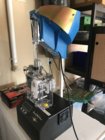270WinDude, here is a quote from a post I made back in June of 2017. It was concerning when to anneal in relation to sizing, but the part of that post I am including refers to my results when annealing after every firing.
I keep my brass in lots for each rifle, for example my heavy gun has 195 pieces of brass in the lot. All same lot# from Lapua, all made at the same, same neck turner setting, same amount of firings (within 1), etc. Basically as identical as possible.
Before I got an AMP I would usually see three distinct groups of seating force with this brass. Each piece of brass within a group was within 5 inch pounds of the rest, with three total 5 in/lb groups. About 5% of those 195 pieces usually fell outside of that range and were used as foulers.
I now anneal after every firing.
Clean necks > anneal > size
I am seating using the K&M Arbor Press with Force Pack
After the first time annealing with the AMP all 195 pieces were within 5 in/lb of each other.
After the second time they were all within 2 in/lb of each other.
The 2 in/lb has remained constant so far.
Since that time, the same lot of brass is still within that 2 in/lb range. This is measured on my KM Arbor Press with the force gauge.
I also anneal brass for my shooting partner. He usually has me anneal his brass every 3-4 firings, which is when he can feel differences in neck tension with his arbor press.
I keep my brass in lots for each rifle, for example my heavy gun has 195 pieces of brass in the lot. All same lot# from Lapua, all made at the same, same neck turner setting, same amount of firings (within 1), etc. Basically as identical as possible.
Before I got an AMP I would usually see three distinct groups of seating force with this brass. Each piece of brass within a group was within 5 inch pounds of the rest, with three total 5 in/lb groups. About 5% of those 195 pieces usually fell outside of that range and were used as foulers.
I now anneal after every firing.
Clean necks > anneal > size
I am seating using the K&M Arbor Press with Force Pack
After the first time annealing with the AMP all 195 pieces were within 5 in/lb of each other.
After the second time they were all within 2 in/lb of each other.
The 2 in/lb has remained constant so far.
Since that time, the same lot of brass is still within that 2 in/lb range. This is measured on my KM Arbor Press with the force gauge.
I also anneal brass for my shooting partner. He usually has me anneal his brass every 3-4 firings, which is when he can feel differences in neck tension with his arbor press.











